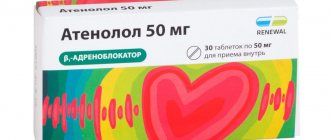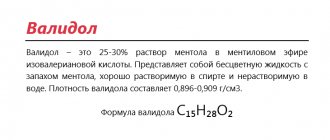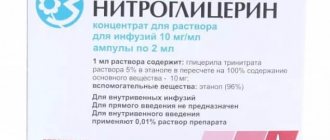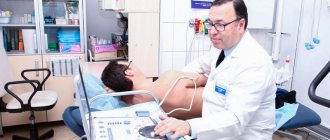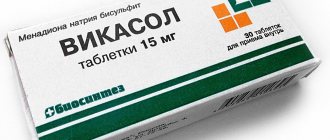Pharmacological properties
Pharmacodynamics
Phenilin is an indirect anticoagulant. The drug causes hypoprothrombinemia, disrupting the formation of prothrombin in the liver, and reduces the formation of coagulation factors VII, IX and X. The cumulative effect of Phenilin is more pronounced than that of neodicoumarin. When administered orally, a decrease in the concentration of coagulation factors is observed 8–10 hours after administration, and the maximum decrease occurs after 24–30 hours.
Pharmacokinetics
The drug is quickly and almost completely absorbed after oral administration. Phenilin passes through histohematic barriers and is able to accumulate in tissues.
Metabolism occurs in the liver. The drug is excreted by the kidneys both in the form of metabolites and unchanged.
Phenilin: instructions, reviews, analogues, price in pharmacies
active ingredient: phenindione;
1 tablet contains phenyline (phenindione) 30 mg
excipients: lactose, potato starch, talc, citric acid monohydrate.
Pharmacological group
Antithrombotic agents. Vitamin K antagonists.
ATS code B01A A02.
Indications
Prevention and treatment of thrombosis (especially deep veins of the lower extremities), thromboembolic complications (pulmonary embolism, embolic stroke, myocardial infarction) and thrombus formation in the postoperative period in patients with mechanical prosthetic heart valves.
Contraindications
Hypersensitivity to the components of the hemophilia drug; threat of miscarriage; large postoperative wounds; bleeding from the digestive, respiratory, and genitourinary systems; recent surgery or injury to the brain/spinal cord, eyes, recent lumbar anesthesia, liver or kidney biopsy; severe hepatic and/or renal failure, hemorrhagic diathesis; hypocoagulation (initial prothrombin level less than 70%); erosive and ulcerative lesions of the gastrointestinal tract; severe arterial hypertension; patients who do not cooperate with the doctor.
Directions for use and doses
Administer to adults and children over 14 years of age (with a body weight of at least 45 kg) orally after meals.
The dose is determined by the doctor individually, taking into account sensitivity to the drug, the nature of the disease, dietary habits and concomitant treatment.
For adults, prescribe on the first day of treatment a daily dose of 120-180 mg (4-6 tablets) in 3-4 doses, on the second day - a daily dose of 90-150 mg (3-5 tablets), then - 30-60 mg (1-2 tablets) in 1-2 doses depending on the level of prothrombin in the blood.
Children over the age of 14 years (with a body weight of at least 45 kg) are prescribed on the first and second days of treatment at a daily dose of 90-150 mg (3-5 tablets) in 3-4 doses, then 30-60 mg (1 - 2 tablets) in 1-2 doses depending on the level of prothrombin in the blood.
The single dose, frequency and duration of use are set individually by the doctor depending on the value of the prothrombin index of the blood, which is maintained at 40-60%. If the prothrombin level is less than 40-50%, the drug should be discontinued immediately.
To prevent thromboembolic complications, prescribe 30 mg (1 tablet) 1-2 times a day.
Higher doses for adults: single – 50 mg, daily – 200 mg.
The drug should be discontinued gradually.
Adverse reactions
From the blood coagulation system: with long-term use - micro- and macrohematuria, bleeding from the oral cavity and nasopharynx, gastrointestinal bleeding, hemorrhages into the muscles.
From the blood: inhibition of bone marrow hematopoiesis (agranulocytosis, leukopenia, leukemoid reactions).
From the digestive system: nausea, vomiting, diarrhea, sore throat, taste disorders, stomatitis, toxic hepatitis, jaundice, ulcerative colitis, paralytic ileus with bloating.
From the cardiovascular system: myocarditis.
Allergic reactions: skin rash (erythematous, macular, papular), exfoliative dermatitis, eosinophilia, hyperthermia, massive edema, skin necrosis.
From the urinary system: impaired renal function, pink urine, albuminuria.
Other: headache, orange coloration of palms.
Overdose
Symptoms: hemorrhagic syndrome (gastrointestinal, uterine, nosebleeds, hematuria, hemorrhages in the skin, muscles, parenchymal organs).
Treatment: discontinuation of the drug, taking vitamin K orally (5-10 mg).
If serious bleeding develops, vitamin K should be administered intravenously slowly (1 mg/min) in a total dose of 10-50 mg (normalizes the increased prothrombin time within 6:00).
In case of massive bleeding or patients with liver failure, simultaneously administer fresh frozen plasma. It is possible to use aminocaproic acid, vitamins C and P.
Use during pregnancy and lactation
The drug is contraindicated during pregnancy (especially in the first trimester and in the second half of the third trimester). The drug should not be used in the first days after childbirth. If it is necessary to use the drug, breastfeeding should be discontinued.
Children
Use the drug in children over 14 years of age with a body weight of at least 45 kg.
Features of application
Prescribe the drug with caution to elderly patients (increased risk of bleeding, especially intracranial), with moderate hepatic and/or renal failure, increased vascular permeability, pericarditis, in the postpartum period, and with gynecological diseases.
Particular attention is required when using oral anticoagulants in patients before undergoing surgery, including tooth extraction.
Intramuscular and subcutaneous injections during treatment should be performed with caution to avoid the occurrence of hematomas; The risk of bleeding is increased in patients with congestive heart failure, with a tendency to thrombosis, as well as in women over the age of 60 years.
For acute thrombosis, prescribe together with heparin.
During treatment, systematic monitoring of the prothrombin ratio (normal values are 2.0-4.0), regular extended coagulation blood tests (coagulogram, thromboelastogram, platelet count), and urine analysis for early detection of hematuria are necessary.
To control anticoagulant activity, use the PT indicator: reliable prevention of venous thrombosis is achieved by increasing the PT by 2 times, arterial by 3-4 times (the norm is 11-14 s).
The drug should not be prescribed during menstruation (you should stop taking it 2 days before it starts) and in the first days after childbirth.
The coloring of urine pink and palms orange is due to the metabolism of phenindione (transition to the enol form) and is not dangerous. When urine is acidified, its color changes, which can be used to differentiate the color of urine from hematuria. If the palms are stained and the color of urine changes, it is recommended to replace the drug with another anticoagulant, with the exception of omefin.
The ability to influence the reaction rate when driving vehicles or other mechanisms
During the treatment period, you should refrain from driving vehicles and potentially dangerous activities that require increased concentration and speed of psychomotor reactions.
Interaction with other drugs and other types of interactions
The effect of the drug is enhanced by thrombolytic, antiplatelet agents, anticoagulants, ACTH, anabolics, azathioprine, allopurinol, amiodarone, anesthetics, narcotic analgesics, androgens, antibiotics, tricyclic antidepressants, drugs that oxidize urine, glucocorticosteroids, diazoxide, disopyramide, nalidixic acid, isoniazid, clofibrate , metronidazole, paracetamol, reserpine, vitamin E, butadione, sulfonamides, disulfiram, quinidine, cyclophosphamide, thyroid hormones, iodine preparations, liquid paraffin, cimetidine and other microsomal oxidation inhibitors. The effect of the drug is weakened by vitamin K, propranolol, urine decongestants, antacids, cholestyramine, phenazone, haloperidol, diuretics, carbamazepine, barbiturates, oral contraceptives, rifampicin.
Pharmacological properties
Pharmacodynamics. The drug affects blood clotting and platelet function. Indirect anticoagulant.
The mechanism of action is due to competitive antagonism with vitamin K. Phenindione blocks vitamin K reductase, disrupts the formation in the liver of the active form of vitamin K, necessary for the synthesis of prothrombin and other blood coagulation factors (VII, IX and X). Causes hypoprothrombinemia.
Reduces plasma tolerance to heparin, blood lipid levels and improves vascular permeability.
The hypocoagulant effect (decrease in the concentration of blood coagulation factors) develops gradually (due to the action of previously synthesized blood coagulation factors), manifests itself after 8-10 hours and reaches a maximum 24-36 hours after administration. Duration of action is 1-4 days after discontinuation of the drug.
Pharmacokinetics. After oral administration, it is quickly and almost completely absorbed. The connection with proteins is not strong. Passes through histohematic barriers (including placental), accumulates in tissues. Metabolized in the liver with the participation of cytochrome P450. It is excreted by the kidneys unchanged and in the form of metabolites. Can accumulate.
Basic physical and chemical properties
tablets are white or white with a creamy tint, flat-cylindrical in shape with a bevel. Inclusions are allowed.
Storage conditions
Store in original packaging at a temperature not exceeding 25 ° C.
Keep out of the reach of children.
Package
Tablets of 30 mg No. 20 in a blister in a box.
.
Location
Ukraine, 61013. Kharkov, st. Shevchenko, 22.
Source: https://www.medcentre24.ru/medicamenty/fenilin.html
Contraindications
Absolute:
- increased vascular permeability;
- hemorrhagic diathesis and other diseases accompanied by a decrease in blood clotting;
- initial prothrombin level less than 70%;
- pericarditis;
- malignant neoplasms;
- menstrual period;
- pregnancy period (first trimester);
- postpartum period;
- lactation period;
- hypersensitivity to the components of the drug.
Relative (Phenilin is used with caution):
- pulmonary embolism (including in oncology);
- impaired renal and liver function;
- erosive and ulcerative lesions of the gastrointestinal tract;
- elderly age.
PHENYLIN, PHENYLIN – instructions for use of the medicine, reviews, description, price
Phenilin is a drug (tablets) that corresponds to the anticoagulant group. The instructions for use highlight the following features of the drug:
How to dissolve vascular plaques, normalize blood circulation, blood pressure and forget the way to the pharmacy
- Sold only with a doctor's prescription
- For liver dysfunction: with caution
- If renal function is impaired: with caution
- In old age: with caution
Pharmacodynamics and pharmacokinetics
The use of this drug affects blood clotting and is an indirect anticoagulant.
Its intake promotes the development of hypoprothrombinemia, caused by impaired formation of prothrombin in the liver, reduces the formation of factors VII, IX and X. At the same time, Phenilin has a greater cumulative effect compared to neodicoumarin.
As a result of internal administration, the concentration of blood coagulation factors decreases within 8-10 hours, the maximum effect is achieved after 24-30 hours.
The drug is characterized by rapid and complete absorption. The active component penetrates the histo-hematological barriers, accumulating in the tissues. Metabolism occurs in the liver. The substance is excreted by the kidneys in unchanged form and metabolites.
Release form
No. 20 in a blister in a box. Composition: 1 tablet of Phenylin contains phenylin (phenindione) 30 mg. Excipients: lactose monohydrate, potato starch (in terms of starch with a moisture content of 10%), talc, citric acid monohydrate.
The drug is available in 30 mg tablets.
| Pills | 1 tab. |
| Fenyndion | 30 mg |
| Excipients: citric acid, starch, milk sugar, talc. |
Contraindications for use
The drug is not prescribed to patients with:
- initial prothrombin level up to 70%;
- hemorrhagic diathesis and other diseases associated with decreased blood clotting;
- dysfunction of the liver and kidneys;
- increased vascular permeability;
- malignant neoplasms;
- ulcerative diseases of the gastrointestinal tract;
- pericarditis.
In addition, the medicine is not recommended for use at the beginning of pregnancy, during menstruation, or for several days after childbirth.
Analogs
Drugs with similar effects are such drugs as Plestasol, Sinkumar, Atrombone, Atherocard, Warfarin, Gedulin, Atrogrel, Acecardine, Diofindal, Agrelide, Pindion, Tromazal, Thrombozol, Phenindione, Trombantine, Phenylindandione and other drugs.
It is worth considering that all these drugs may have different effects on the body, as well as costs. That is why the selection of an analogue should only be carried out by a specialist.
Analogs by ATX code: no.
Medicines with a similar mechanism of action (matching level 4 ATC code): Fenindione, Daniloi, Atrombone, Dindevan, Diofindan, Gedulin.
Do not decide to change the drug on your own; consult your doctor.
MORE ABOUT: Groups of drugs for the treatment of arterial hypertension
What do they say about a drug like Phenilin? Reviews from doctors and patients will be reviewed at the very end of the article. We will also tell you about the purposes for which this drug is prescribed, how to take it correctly, whether it has side effects, analogues and contraindications.
Composition and form
In what form is the drug “Phenilin” produced? The instructions for use indicate that this drug is available in tablets, the active substance of which is phenindione. Milk sugar, starch, citric acid and talc are used as auxiliary ingredients.
Pharmacodynamics
What pharmacological properties does the drug “Phenilin” have? The instructions for use state that this drug has a direct effect on blood clotting. It is an indirect anticoagulant.
Taking the medication contributes to the occurrence of hypoprothrombinemia, which is caused by impaired formation of prothrombin in the liver. This agent also significantly reduces the formation of factors 7, 9 and 10. Moreover, it has a greater cumulative effect compared to neodicoumarin.
After oral administration of tablets, the concentration of blood clotting factors decreases within 8-10 hours. The maximum effect of the drug is observed after 25-30 hours.
Pharmacokinetics
Is the drug "Phenilin" absorbed into the systemic circulation? Reviews from experts say that this medication is characterized by complete and fairly rapid absorption. Its active ingredient penetrates the histo-hematological barriers and accumulates in tissues.
The drug is metabolized in the liver and excreted through the kidneys (in the form of metabolites and unchanged).
For what purpose are Phenilin tablets prescribed? Reviews from experts report that this drug is used for both treatment and prevention.
The main indications for use are thrombosis, thrombophlebitis, thromboembolic complications caused by embolic stroke and myocardial infarction, as well as similar disorders.
In addition, the medication in question is often prescribed to prevent blood clots after surgery.
Under what conditions of the patient is it prohibited to take the drug "Phenilin"? Instructions for use indicate the following contraindications:
- disorders of the kidneys and liver;
- initial prothrombin level up to 70%;
- increased vascular permeability;
- hemorrhagic diathesis and other diseases associated with decreased blood clotting;
- peptic ulcers of the gastrointestinal tract;
- malignant neoplasms;
- pericarditis.
It must also be said that the medicine in question is not recommended for use at the very beginning of pregnancy, for several days after childbirth and during menstruation.
The medication in question is used only for oral administration. Its therapeutic regimen has certain features; therefore, this medicine should be used only as prescribed by a doctor.
The initial daily dose of the drug is usually 0.11-0.17 g (4 times a day). The next day, the amount of the drug is reduced to 0.08-0.14 g, and subsequently to 0.02-0.05 g. After this, the dosage of the tablets depends on the level of prothrombin in the blood.
The maximum amount of the drug at a time should be 0.05 g, and the daily amount should be about 0.2 g.
Treatment of acute thrombosis requires additional heparin. This requires strict monitoring by a doctor, as well as a mandatory systematic study of the amount of prothrombin in the blood and other factors of its coagulation.
Treatment with the drug "Phenilin", analogues of which we will list below, is stopped gradually.
Side effects
Does the medication Phenilin cause side effects? The method of use and dosage of this medicine must be strictly followed.
This is primarily due to the fact that during therapy the patient may experience various allergic reactions in the form of diarrhea, nausea and hepatitis.
Also, according to reviews from doctors and patients, in rare cases, headaches, fever, changes in the color of urine and skin, and problems with hematopoiesis are observed.
In case of overdose, symptoms may worsen in patients, which are considered side effects.
Source: https://bliznesy.ru/preparaty/fenilin-instrukciya-po-primeneniyu.html
Directions for use and dosage
Phenylin is intended for oral administration.
On the first day of treatment, take 120–180 mg of the drug (3–4 times), on the second day – 90–150 mg, on subsequent days – 30–60 mg per day, depending on the concentration of prothrombin in the blood (it is necessary to maintain the prothrombin index within 50–40%). Maximum doses for adults: single – 50 mg, daily – 200 mg.
To prevent thromboembolic complications, Phenilin is prescribed 30 mg 1–2 times a day.
For acute thrombosis, the drug is taken simultaneously with heparin.
Instructions for use of Phenilin
According to the instructions, the dose of the drug is selected according to the duration of prothrombin time, maintaining the prothrombin index at the level of 40-60%. On the first day, the loading dose is 120-180 mg orally in 3-4 doses, on the second day – 90-150 mg/day, then – under the control of PTT, 30-60 mg/day. The maximum daily dose of Phenilin is 200 mg.
While taking the drug, you should regularly monitor the coagulogram, thromboelastogram, platelet levels in the blood, and urine for possible hematuria.
Treatment with the drug should be discontinued gradually. Sometimes patients' palms turn yellow and their urine turns pink. In case of an overdose of Phenilin, vitamin K will be its antagonist; in acute cases it is administered parenterally.
Side effects
- digestive system: toxic hepatitis, nausea, liver dysfunction, diarrhea;
- cardiovascular system: myocarditis;
- central nervous system: headache;
- hematopoietic system: inhibition of hematopoiesis in the bone marrow;
- blood coagulation system: with long-term treatment - bleeding from the nasopharynx and oral cavity, microhematuria, macrohematuria, hemorrhages in the muscles, bleeding from the gastrointestinal tract;
- urinary system: renal dysfunction;
- allergic reactions: dermatitis, skin rash, fever, eosinophilia.
special instructions
Throughout the entire period of therapy with Phenilin, the patient must be under the strict supervision of a physician. It is necessary to systematically determine the level of prothrombin and other coagulation factors, as well as conduct a general urine test for the early detection of hematuria.
In some patients, the palms of the hands may turn orange and the urine may turn pink, which is due to the metabolism of the drug and does not pose a danger.
Treatment with Phenilin should be discontinued gradually.
Impact on the ability to drive vehicles and complex mechanisms
The drug does not affect the ability of patients to drive vehicles or operate other complex machinery.
PHENILIN
Fenilin
(
Phenylinum
; synonym:
Athrombon, Danilone, Emandione, Fenilin, Hedulin, Phenindionum, Phenylindandionum, PJD, Pindione, Thrombophen, Thrombantin, Trombosol,
etc.; GPC, list A) is an indirect anticoagulant. 2-Phenylindanedione-1,3; C15H10O2:
White or creamy white crystals. Very slightly soluble in water, slightly soluble in 95% alcohol; t°melt 148-151°; molecular weight (mass) 222.24 Solutions are orange to orange-red in color.
Like other indirect anticoagulants (see Anticoagulants), phenylin reduces blood clotting only in the body. It is an antimetabolite of vitamin K and therefore inhibits the biosynthesis of blood coagulation factors II (prothrombin), VII (proconvertin), IX (antihemophilic globulin B), X (Stewart-Prower factor) in the liver. A decrease in the concentration of these factors in the blood plasma occurs 8-10 hours after taking phenyline, and the maximum effect develops after 24-30 hours and gradually weakens over several days. It accumulates to a greater extent than neodicoumarin, and in this ability is close to nitrofarin and syncumar (see Acenocoumarol).
Quickly and completely absorbed from the gastrointestinal tract. Maximum concentrations accumulate in the blood 1-3 hours after ingestion. It disappears relatively quickly from the blood plasma, accumulating mainly in the liver and to a lesser extent in the intestines and lungs. Partially deposited in erythrocytes. The half-life of phenyline from the blood is about 5 hours. Long-term use in some patients may cause palms to turn orange and urine to turn pink, which is explained by the conversion of phenyline in the body to the enol form and is not dangerous. The rate of metabolism of phenyline in humans is lower compared to neodicoumarin (see). Large fluctuations in the rate of biotransformation of phenylin in different patients were noted. It is excreted through the kidneys mainly in the form of metabolites.
Like other indirect anticoagulants, phenylin is used
for long-term reduction of blood clotting in order to prevent and treat thromboembolic complications.
On the 1st day, phenyline is prescribed
orally for adults, usually in a daily dose of 0.12-0.18 g (in 3-4 doses), on the 2nd day - in a daily dose of 0.09 - 0.15 g, in subsequent days - in so-called maintenance doses, which range from 0.03 to 0.06 g per day. The dose is adjusted in accordance with blood coagulation parameters. The optimal therapeutic level for reducing hemocoagulation is recognized to be one at which the Quick thromboplastin time is extended by 2-2.5 times, which corresponds to the prothrombin index in the range of 40-50%. For long-term reduction of blood clotting in order to prevent thrombosis, phenyline is prescribed 0.03 g 1 - 2 times a day. In acute cases of thrombosis, on the first day, treatment with phenylin is combined with the administration of heparin (see).
Higher doses for adults orally: single 0.05 g, daily 0.2 g, phenylin can cause allergic reactions in the form of dermatitis, fever, diarrhea, vomiting, development of hepatitis, inhibition of hematopoiesis.
To avoid overdose during treatment with phenylin, along with monitoring blood clotting, it is advisable to test urine to identify possible hematuria. In case of overdose, reduce the dose or discontinue the anticoagulant. Vitamin K is a specific antagonist of phenylin.
Contraindicated
in the same cases as other anticoagulants (with reduced blood clotting, pregnancy, stomach and duodenal ulcers, etc.).
Release form:
powder, tablets 0.03 g each. Storage: powder - in a well-closed container, protected from light, tablets - in a place protected from light.
Bibliography:
Current problems of hemostasiology, ed. V.V. Petrovsky and others, p. 430, M., 1981; Lyusov V. A., Belousov Yu. B. and Bokarev I. N. Treatment of thrombosis and hemorrhages in the clinic of internal diseases, M., 1976; Malinovsky N. N. and Kozlov V. A. Anticoagulant and thrombolytic therapy in surgery, M., 1976; Chazov E. I. and Lakin K. M. Anticoagulants and fibrinolytic agents, M., 1977.
K. M. Lakin.
Reviews about Fenilin
Drugs with similar effects are actively discussed on various medical portals and forums. Among similar medicines, Phenilin is the most effective.
As a result of treatment with the drug, blood clotting indicators improve. Also, according to reviews, Phenilin helps improve the patient’s general condition, numbness in the legs disappears, and cramps occur less frequently.
Such a side effect as increased nosebleeds is, according to doctors, the norm and completely disappears after a course of treatment.

